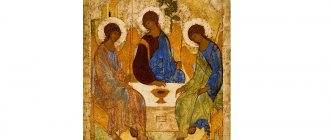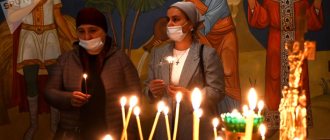There is a Day of Remembrance and Sorrow in our country; a tragic date in the history of the country is June 22. In 1941, he divided the lives of millions of Soviet people into before and after, where before is happiness, light, and everyone is still alive, and after is the death of millions of people, the destruction of hundreds of cities, villages and towns, unbearable pain from the atrocities committed by the Nazis and their henchmen in the occupied territories.
What is June 22 for Russia?
Decree of the President of the Russian Federation B.N. Yeltsin dated June 8, 1996 No. 857 declared June 22 a Day of Remembrance and Sorrow. Events held on this day should preserve the memory of a new generation of Russian citizens about the terrible trials that befell the Soviet people. This is a day of remembrance for all those who died in battle, were tortured in death camps and Gestapo dungeons, and died of hunger, cold and disease.
This is a tribute to the memory of all those who, at the cost of their lives, achieved Victory, stood at machines for days, worked in the field, in factories, spent whole days at operating tables, saving the wounded, women and children, on whose shoulders fell responsibility and care for their families. All those who starved and suffered from the cold, received funerals, suffered from the unknown about their loved ones and relatives. A tribute to the entire Soviet people who saved our state and the world from fascist barbarians.
International Holocaust Remembrance Day – January 27
On January 27, 1945, during the Soviet offensive, the first and largest of the Nazi death camps, Auschwitz or Auschwitz-Birkenau, was liberated. During the five years of its existence, from May 20, 1940, about 1.4 million people passed through the camp, of whom more than 1.1 million were brutally killed or died as a result of torture, disease or starvation. The majority of them were Jews - about 960 thousand - 90% of whom died in the gas chambers immediately upon arrival at the camp.
Auschwitz has become one of the main symbols of the Holocaust, so it is not surprising that in November 2005 the UN General Assembly decided to make the day of its liberation an international date of remembrance of the victims of the systematic extermination of Jews, as well as millions of representatives of other ethnic social groups, including Slavs, Gypsies, people with mental disorders and disabilities, religious and sexual minorities. The initiative to adopt this resolution, numbered 60/7, was taken by Israel, Canada, Australia, Russia, Ukraine and the United States, and more than 90 states participated in the writing of its text. In addition to the unconditional recognition and condemnation of the Holocaust, the authors of the document declared the inadmissibility of any manifestations of racism, ethnic and religious intolerance.
In addition to Holocaust Remembrance Day, Russia annually celebrates the International Day of the Liberation of Nazi Concentration Camp Prisoners (April 11) and the Day of Remembrance for the Victims of Fascism (September 13).
Where and how do you spend June 22nd?
Events are held in cities, villages and towns for the Day of Remembrance and Sorrow; they help to preserve in people’s minds all the events of that terrible time. Nowadays, this is also necessary because many fictions have appeared about the events of the Second World War. They are intended to erase the truth about the great Victory from the people’s memory. This is being done in order to belittle the crimes of the fascists and present our people in the image of occupiers who conquered half of Europe.
Will the “Candle of Memory” campaign take place in a traditional format?
Despite a number of restrictions in many cities due to the spread of coronavirus infection, the event will still take place in the format familiar to many. The information has already been confirmed by the Moscow organizing committee - in the capital they plan to light 1,418 candles near the Victory Museum at midnight. At the beginning, the ensemble of the Russian Guard will perform for the participants, then the memory of the victims will be honored with a minute of silence, after which candles will be lit. At the same time, a video installation will be broadcast on the facade of the museum building. You can find out information about the event in your city on official resources.
We need the truth about the war
The rallies on June 22, the Day of Remembrance and Sorrow, are designed to strengthen our spirit, unite the entire people and remember that this helped the Soviet people survive the terrible years of the war. We must treat the history of our country with pride and great respect. Do not just look for some dark facts, as is done in our time, but accept it as it is. We must remember that history does not accept the subjunctive mood.
There is no need to listen to those who, sitting on the couch, think about what should have been done and what, in their opinion, was done wrong. We need to respect what happened - this is our history. We need the truth about the war, in particular about its first day with its failures, unprecedented losses and disappointments.
It was this first day that shattered the myth of the blitzkrieg, planted the seeds of doubt in the fascists, this can be understood from the words of Hitler, who said that we opened the door, but we don’t know what’s behind it, thwarted hopes of reaching Moscow, as we did to Paris, beyond a few days. It was the heroism of the border guards and military personnel that made it possible to detain the Nazis in order to begin the evacuation of enterprises and mobilize the population.
Start of the war
At events dedicated to the Day of Remembrance and Sorrow, they will definitely talk about the beginning of a terrible war. On this day, June 22, 1941, at 4.30, without declaring war, Nazi Germany launched an artillery strike on border fortifications and outposts in the area from the Carpathians to the Baltic, after which hordes of fascists crossed the state border. Before this, early in the morning, at 3.30, air strikes were carried out on all border strategic targets.
Cities such as Riga, Kaunas, Siauliai, Vilnius, Grodno, Lida, Brest, Minsk, Baranovichi, Zhitomir, Bobruisk, Sevastopol, Kyiv and many others were also bombed from the air. In the first hours of the war, without understanding what was happening, a large number of Soviet civilians died.
This was the beginning of a terrible, difficult and long road to Victory, a road full of losses, grief and hopes. The day that we celebrate as the Day of Remembrance and Sorrow has irrevocably turned the lives of tens of millions of people upside down. It was a terrible and heroic time that passed through the destinies of people, forcing them to become stronger and wiser.
Day of Remembrance of Russians who performed their official duties outside the Fatherland - February 15
Since 2011, Russia has annually celebrated an important memorial date designed to honor the memory of Russian military personnel who died in the line of duty on the territory of other states. The date was not chosen by chance: it was on February 15, 1989 that the last column of Soviet soldiers crossed the bridge across the Amu Darya, along which the Afghan-Soviet border passed, thus ending the Afghan War. This event marked the end of an almost 10-year conflict in which, according to various estimates, from 15 to 26 thousand military personnel died.
Since then, the Afghan Veterans' Day has also become an official day of remembrance and mourning for all internationalist soldiers who took part in almost 50 armed conflicts (from 1936 to the present day) outside the country. In honor of this date, many Russian cities host ceremonial events and commemorative rallies, exhibitions, concerts and laying flowers at monuments.
The heroism of Soviet border guards
The initial blows were taken by the border guards, who were the first to engage in battle with Nazi regular units and delayed their advance for many hours. For a whole month, surrounded Brest fought in complete isolation, detaining selected units of the Nazis. After the fortress fell, the border guards located in its basements continued to fight. The last defender was captured only in the summer of 1942.
June 22 is the Day of Remembrance and Sorrow, so we must remember that not one of the 484 border outposts that were attacked on the first day of the war withdrew without orders. Sometimes the Germans captured them only after all the border guards were killed. The Nazis did not take Soviet soldiers wearing green caps prisoner.
Did the USSR want war?
A lot has been written about this terrible Day of Remembrance and Sorrow; it has been studied literally minute by minute. Documents were declassified, allowing historians to conduct a comprehensive analysis. But starting from the 90s, they began to convince us that this war was the result of a conspiracy between Stalin and Hitler, equating the two regimes.
But the documents tell a different story. The Soviet country did not want war, delaying its start in every possible way. The country's leaders, diplomats, and military men, knowing what policy Germany was pursuing, which, before starting military operations against the USSR, put half of Europe under its boot, had no doubt that there would be war.
W. Churchill spoke well about Hitler's treachery when speaking to his compatriots on this day. Having no sympathy for the USSR, he called the German government treacherous and noted that the German ambassador to the USSR until the last second, smiling flatteringly, lavished courtesy on behalf of the government, assuring “friendship and almost an alliance,” and after the German invasion he went to Molotov with a note in which he laid out a bunch of claims to Russia. Why weren't we talking about them before?
Day of Remembrance for Victims of Political Repression – October 30
On October 30, Russia and other countries of the former USSR celebrate the Day of Remembrance for Victims of Political Repression. This memorial day was established by decision of the Supreme Council of the RSFSR on October 18, 1991 in memory of the hunger strike, which in 1974 was declared by political prisoners and other prisoners in camps throughout Mordovia on the initiative of K.A. Lyubarsky against the inhumane treatment of them by the guards. Until 1991, October 30 was celebrated as Political Prisoner Day in the USSR.
April 21, 2020
You might be interested:
- Minute of silence
- Mass grave and mass grave
- Field burials of the Great Patriotic War
Chronology of the first half of the day the war began
On the Day of Remembrance and Sorrow, people remember the first day of the war, although for those who did not experience it, it is difficult to imagine what was happening then. Terror and fear were in the air as bombs rained down from the sky on the sleeping people. Based on archival documents and eyewitness accounts, the details of that terrible day were reconstructed:
- 3.30. A massive air raid was carried out on the cities of Belarus. Baranovichi, Brest, Kobrin, Grodno, Slonim, Lida and others were bombed.
- 3.35. There are reports of air raids on Ukrainian cities. The first strikes were carried out on the capital of Ukraine - the city of Kyiv.
- 3.40. General Kuznetsov, commander of the Baltic district, reports to headquarters about an enemy air raid on warships and Baltic cities. Naval artillery managed to repel the raid on the ships of the Baltic Fleet, but the cities were destroyed.
- 3.42. Chief of the General Staff G.K. Zhukov gets in touch with Stalin, reports about the German attack on the USSR and receives an order, together with Timoshenko, to urgently come to the Kremlin for an emergency meeting of the Politburo.
- 3.45. A German reconnaissance and sabotage group launched an attack on the 1st outpost of the 86 August border detachment. The border guards took the fight. The saboteurs were destroyed.
- 4.00. An attempt by German planes to bomb the ships of the Black Sea Fleet was repulsed. Sevastopol has been hit and there is destruction in the city.
- 4.05. All border outposts were hit by artillery strikes, after which the Nazis went on the offensive.
- 4.30. A Politburo meeting begins, at which Stalin expresses doubts about the start of the war. Zhukov and Tymoshenko are convinced that this is war.
- The German Ambassador to the USSR presents a note from the German government to the USSR government. De jure Germany declares war on the USSR.
- 12.00. On this Day of Remembrance and Sorrow, V. Molotov informed Soviet citizens about the beginning of the war. The whole people listened to his speech with bated breath, with tears in their eyes. Most people still remembered the Civil War and the First World War and their consequences, so they had no illusions.
Chronology of the second half of the day the war began
For the Soviet Union, this attack was a complete surprise. The rearmament of the Red Army has just begun. The Nazis were counting on this. But from the first hours of the war it was clear that the blitzkrieg in Russia would not give the same results as, for example, in France. As reports from German generals show, they could not expect such desperate resistance. But, nevertheless, the factor of surprise and technical superiority yielded results. This is evidenced by the exhibits of organized exhibitions on the Day of Remembrance and Sorrow:
- 12.30. The city of Grodno fell.
- 13.00. General mobilization declared.
- 13.30. The headquarters of the Supreme High Command was created.
- 14.05. Italy, as an ally of Germany, declares war on the Soviet Union.
- 14.30. Many border outposts, despite the advance of the Germans into the interior of the country, hold back the enemy for 10 hours.
- 18.00. The Russian Orthodox Church blesses all Orthodox Christians to fight the enemy.
- 21.00. The first report from the High Command on the state of affairs at the front. Millions of Soviet people awaited these reports with hope and pain every day.
Day of Solidarity in the Fight against Terrorism – September 3
For 15 years, Russia has been celebrating the Day of Solidarity in the Fight against Terrorism in September. This memorial day was established on July 21, 2005 in connection with the terrorist attack in the North Ossetian city of Beslan, when terrorists seized the city school No. 1. For almost three days, the militants held more than 1,100 hostages in the building, demanding the withdrawal of Russian troops from Chechnya and the release of militants arrested for the attack on Ingushetia, and threatening to blow up the building in the event of an assault. As a result of the terrorist attack, 333 people died, more than 800 were seriously injured, and 141 were left disabled.
On September 3, Russians remember the victims of all terrorist attacks that occurred in the country, as well as rescuers and law enforcement officers who died in the line of duty.











